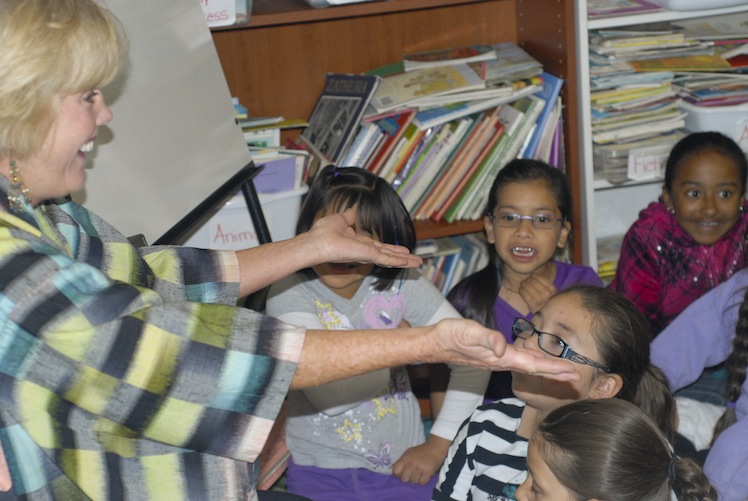By Katy Snyder, [Joining Vision and Action]
Spellbinders is one of our favorite kinds of nonprofits—the kind that brings together two diverse groups for the benefit of both. In Spellbinders’ case, those two groups are elementary school (and sometimes older) kids and older adult volunteers (generally ages 60+, but not always) with a gift for storytelling. Once volunteers have received training on how to most effectively deliver their stories to engage young minds, they meet with the same class of students on a monthly basis to tell classic folktales, fables and sometimes stories of their own creation. This arrangement yields results for all involved: children boost their reading, comprehension and vocabulary skills as they listen and learn, elder volunteers are given a forum to share their accumulated wisdom, and adults and kids alike become more engaged in their communities and with each other.
We wanted to know what Spellbinders could teach us (and our nonprofit readers) about how to best convey our stories, be it stories about clients, stories about our work or stories about our mission—so we went right to the source—interviewing Catherine Johnson, Spellbinders’ executive director, and Ray Mohr, a longtime Spellbinders’ volunteer. Read on to hear what they had to say about how best to convey your nonprofit’s story:
We all have the storytelling gene…
Think that you weren’t blessed with natural storytelling ability? Think again. According to Johnson, research has shown all cultures share a knack for storytelling and that our brains are wired to understand the events of our lives as part of a narrative. So next time you draw a blank when writing about your nonprofit or your clients, think about the challenges they experience and how these challenges are part of a larger story (and keep reading for some guidance on classic tales on which to model your stories).
Don’t get too fancy
Simply put by both Johnson and Mohr, a good story needs a beginning, middle and end. That doesn’t mean that you don’t need to work on crafting a compelling story as long as it has these essential elements—you do need some juicy details—but the structure can be simple. Johnson suggests starting your story by talking about your nonprofit’s clients or founder (e.g., Bethany Larsen’s life seemed promising…), providing some conflict (but then, she lost her job, her home, and eventually, her sobriety), and then giving a resolution (e.g., Bethany had reached rock bottom…but then she found ABC Nonprofit, and things started to look up).
Look to the classics for guidance
According to Johnson (and outlined in the book 7 basic plots: Why we tell stories, by Christopher Booker), there are really only seven types of stories, or archetypes, that all humans, across cultures, tell: overcoming the monster; rags to riches; the quest; voyage and return; comedy; tragedy; and rebirth. All of these story types lend themselves to nonprofits that help clients get back on their feet or access services. For example, the story we used above to illustrate the beginning, middle and end, happens to be an overcoming the monster story. By identifying one of these overarching themes before you write your story, you will be able to organize your story better and make it more vivid for the reader.
Make it compelling
Mohr and Johnson both stressed that stories are made compelling by the characters that they portray. Your characters are your clients. At JVA Consulting, we always recommend that nonprofits tell the story of a real client when they write grants. While a client’s real name should be kept confidential, telling a story of a real person, and how your programs and services have helped him or her, goes a long way in helping your audience connect with your clients and the work you do.
Also, make sure to tell your stories in person, at least some of the time. While this is hard to do when writing a grant or updating your website, make sure to tell stories about your clients (or better yet, get your clients to tell their own stories) at fundraisers, gala dinners or when grantmakers come out to visit your site. Much like Johnson says, stories that are passed on orally are more vivid and engaging than those written on paper because they force the listener to envision what you are saying.
Practice
If you want to truly improve your storytelling skills, you need to practice. A great way to do this? Become a Spellbinders’ volunteer.







Spellbinders sounds like a wonderful organization with great benefit to the volunteers as well as the children. Storytelling can certainly be an act of persuasion, and the most compelling stories are those that engage individuals and leave them wanting to act or to imagine more. While face to face interaction is almost always more meaningful, some of its appeal could be added to an organization’s website by embedding video of a client or team member telling a real story at a gala or fundraiser as you suggested.